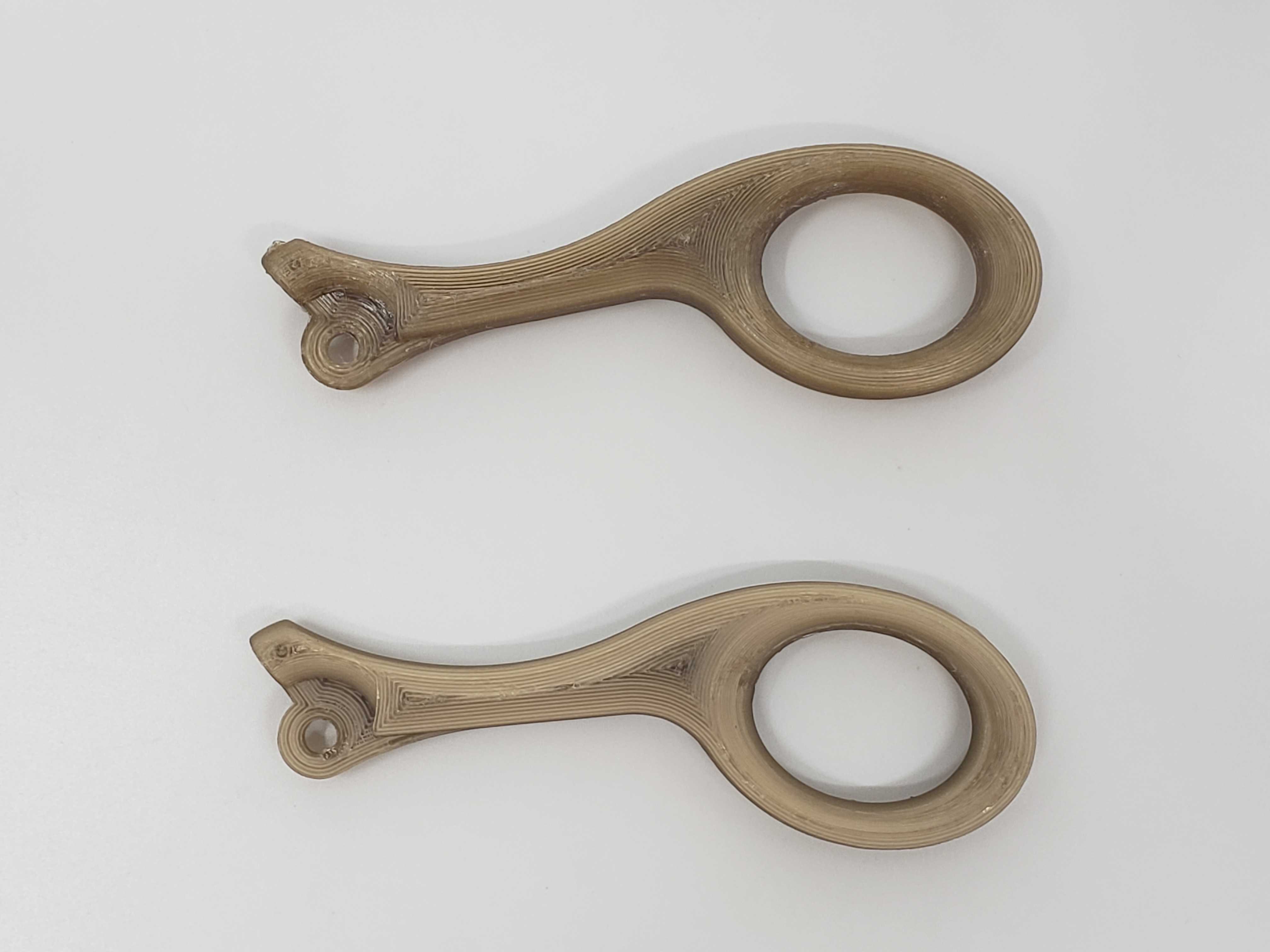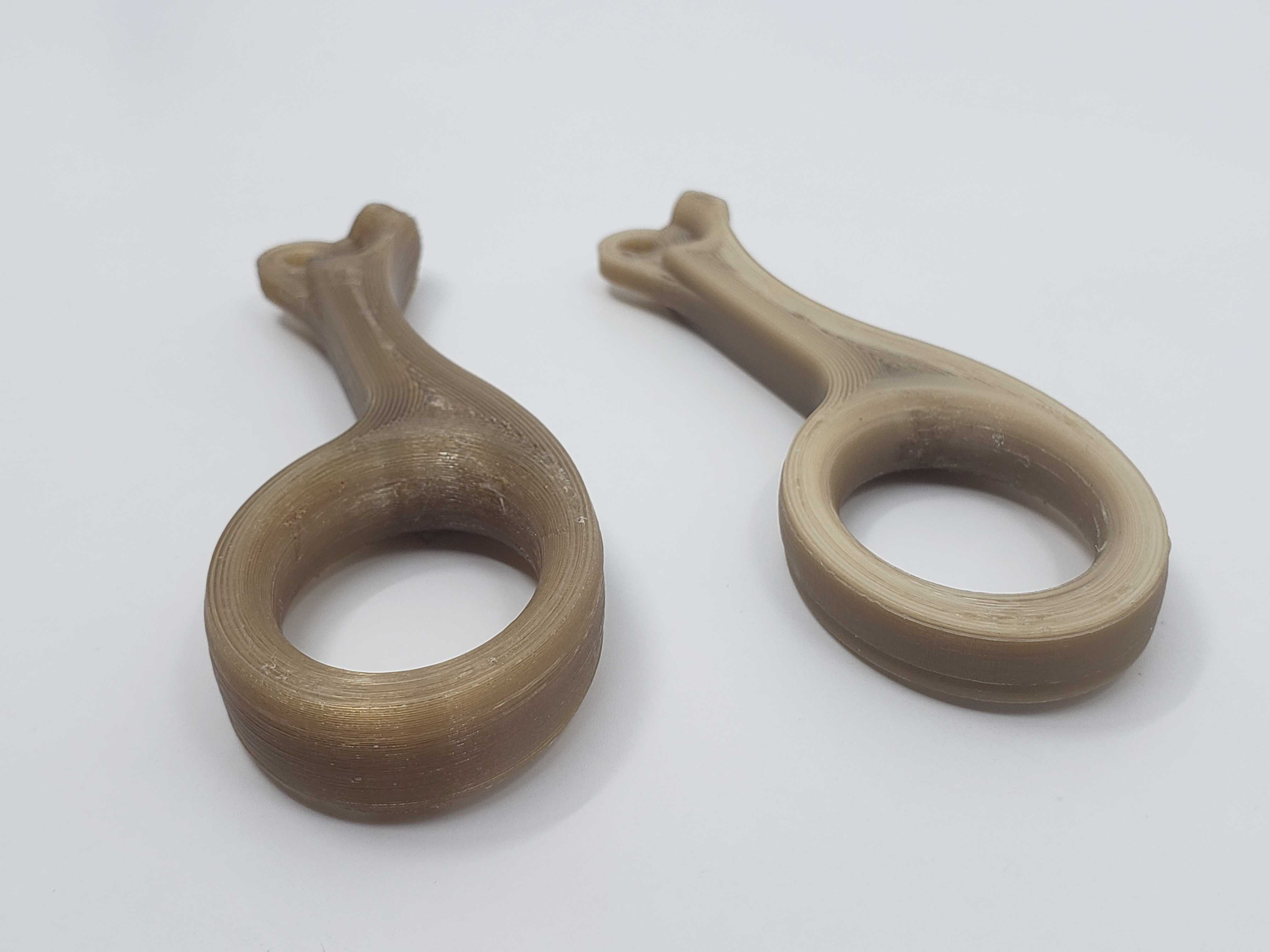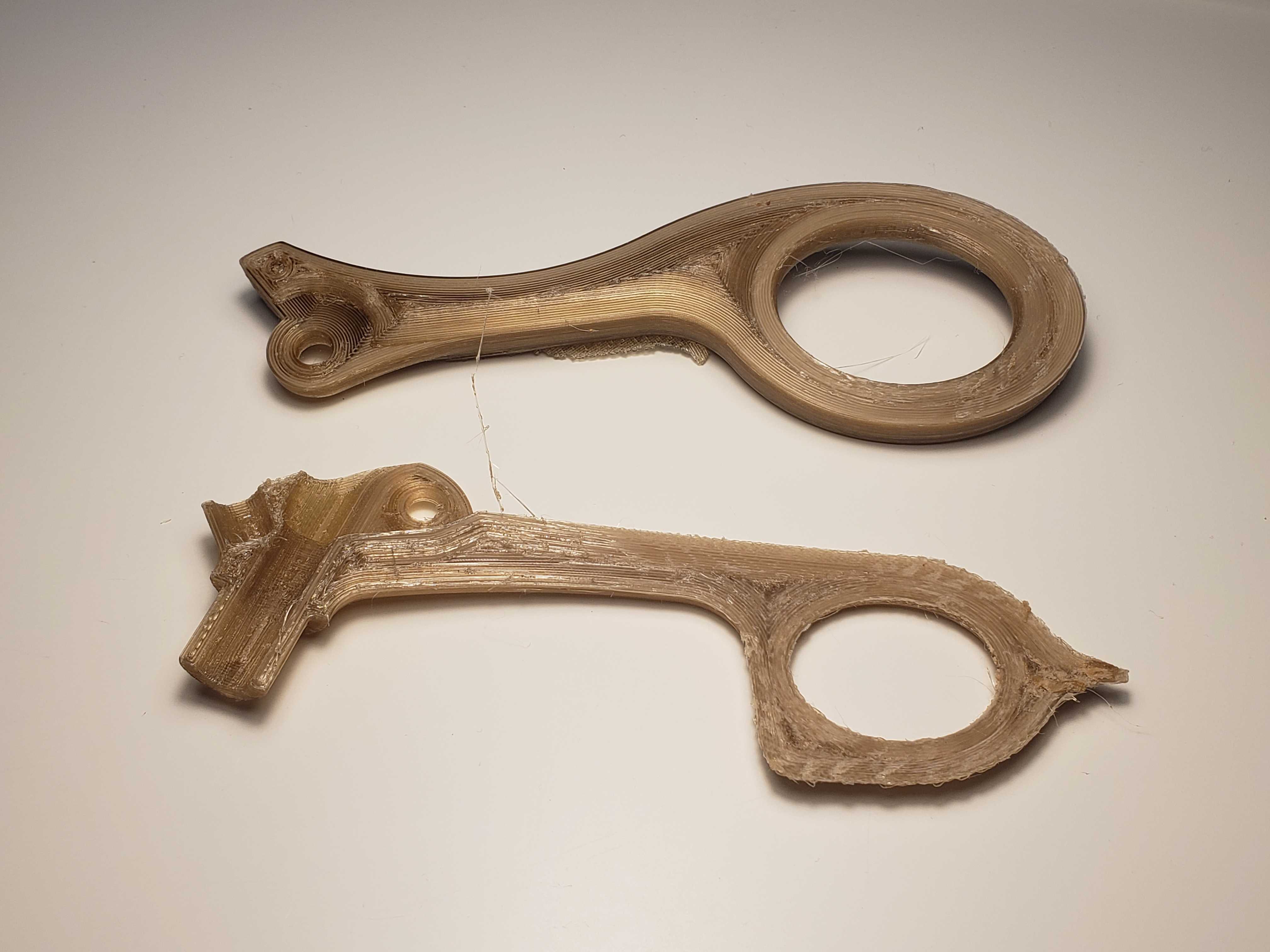Solvay Radel® PPSU
Polyphenylsulfone (PPSU) is an amorphous thermoplastic polymer commonly used where high impact, heat, and chemical resistance are required. Solvay Radel® PPSU filament offers improved ductility, impact resistance, high-temperature capabilities, and chemical resistance compared to PSU and PEI.
Due to its high operating temperatures around 200ºC and flame retardant properties, Radel® PPSU is widely used in multiple sectors, bringing performance to healthcare, energy storage, and aerospace applications.
Printing Difficulty: Challenging/Expert
Radel® PPSU has been replaced by AON3D Readyprint™ PPSU. The print settings are different.
- Moisture Control
- Build Platform Adhesion
- General Process Settings
- Post-Processing
- Technical Specifications
- Troubleshooting
Moisture Control
Radel® PPSU is susceptible to moisture uptake. Bubbles, popping noises, excessive oozing, and stringing may occur if it has been hydrated, see the Stringing and Bulb Defect on Print Surface sections for more information.
The filament can be dried in a convection oven at 150ºC for at least 4 hours before processing and fed from a low humidity environment. When not in use, store in a sealed package or container with silica desiccant to inhibit moisture absorption. Properly dry the material before adjusting process parameters to obtain reliable and consistent results. Our filament dry storage and feed system setup prevents filament moisture uptake to keep the material printing process free of moisture, contact help@aon3d.com for more information.
For more information, see the Filament Drying and Moisture Control guide.
Build Platform Adhesion
For instructions on how to inspect the AON3D build plates, refer to the Inspect and Clean Build Plates procedure.
PEI Build Sheet With Nano Polymer Adhesive
Radel® PPSU prints best on the PPSU build sheet. Part and/or build platform damage may occur during part removal as the interaction between Radel® PPSU and the PEI build sheet is strong. It is recommended to use Nano Polymer Adhesive to act as a release agent and prevent permanent welding of parts to the build surface. Note that Radel® PPSU prints may permanently bond to the PEI build sheet if the first layer adhesion is too great. If needed, lower the first layer extrusion temperature to avoid part and/or build platform damage during part removal.
CF-PEEK Composite Plate With Nano Polymer Adhesive
Radel® PPSU prints well on the CF-PEEK composite plate with the use of Nano Polymer Adhesive, an applied adhesion aid. To successfully print Radel® PPSU, reduce the First Layer Speed and increase the extrusion temperature for the first layer. Increase the First Layer Height and First Layer Width above 120%.
First Layer Settings
First layer adhesion can be increased by increasing the Extrusion Temperature or reducing First Layer Speed. First Layer Height and First Layer Width with a value of 100-150% for both is generally sufficient for Radel® PPSU. Reduce first layer adhesion if you have trouble removing the part and/or you damage the build platform during part removal.
| First Layer Extrusion Temperature | First Layer Speed |
|---|---|
| 380-400ºC | 15-20 mm/s |
For more information, see the Build Platform Adhesion guide.
High-Temperature Build Plate
Radel® PPSU prints best on the High-Temperature Build Plate.
First Layer Settings
If needed, a temperature gradient raft can be used to improve first layer adhesion. The first layer may be thick and can be printed at a high extrusion temperature, then gradually reduced in the raft to optimal extrusion temperatures if needed. Fine-tuning the temperature gradient and printing speed will make the part release from the raft easily. Printing the raft this way will compensate for toolhead shrinkage. Increasing/decreasing thick and thin raft layers will affect raft ease of removal.
For example, the table below illustrates a possible temperature gradient using a raft with 3 thick and 2 thin layers:
| Extrusion Temperature | Raft Layer Size |
|---|---|
| 1. 400ºC | Thick |
| 2. 395ºC | Thick |
| 3. 390ºC | Thick |
| 4. 385ºC | Thin |
| 5. 380ºC | Thin |
| 6. 390ºC | First Layer of Part |
| 7. 390ºC | Second Layer of Part |
As shown above, the first Thick raft layer extrusion temperature is increased to improve first layer adhesion. The extrusion temperature is gradually decreased throughout the raft to optimal extrusion temperatures. The First Layer of Part is extruded at a slightly higher extrusion temperature to avoid separation between the raft and the part.
However, a temperature gradient raft may not be required if the overall extrusion temperatures provide adequate first layer adhesion. If part removal is difficult without damaging the part and/or the build platform, reduce the first layer extrusion temperature.
Start with a First Layer Height and First Layer Width of 100-150% for both and adjust until desired bed adhesion is achieved.
| First Layer Extrusion Temperature | First Layer Speed |
|---|---|
| 380-400ºC | 15-20 mm/s |
For more information, see the Build Platform Adhesion guide.
High-Temperature Build Plate
Radel® PPSU prints best on the High-Temperature Build Plate.
First Layer Settings
If needed, a temperature gradient raft can be used to improve first layer adhesion. The first layer may be thick and can be printed at a high extrusion temperature, then gradually reduced in the raft to optimal extrusion temperatures if needed. Fine-tuning the temperature gradient and printing speed will make the part release from the raft easily. Printing the raft this way will compensate for toolhead shrinkage. Increasing/decreasing thick and thin raft layers will affect raft ease of removal.
For example, the table below illustrates a possible temperature gradient using a raft with 3 thick and 2 thin layers:
| Extrusion Temperature | Raft Layer Size |
|---|---|
| 1. 400ºC | Thick |
| 2. 395ºC | Thick |
| 3. 390ºC | Thick |
| 4. 385ºC | Thin |
| 5. 380ºC | Thin |
| 6. 390ºC | First Layer of Part |
| 7. 390ºC | Second Layer of Part |
As shown above, the first Thick raft layer extrusion temperature is increased to improve first layer adhesion. The extrusion temperature is gradually decreased throughout the raft to optimal extrusion temperatures. The First Layer of Part is extruded at a slightly higher extrusion temperature to avoid separation between the raft and the part.
However, a temperature gradient raft may not be required if the overall extrusion temperatures provide adequate first layer adhesion. If part removal is difficult without damaging the part and/or the build platform, reduce the first layer extrusion temperature.
Start with a First Layer Height and First Layer Width of 100-150% for both and adjust until desired bed adhesion is achieved.
| First Layer Extrusion Temperature | First Layer Speed |
|---|---|
| 380-400ºC | 15-20 mm/s |
For more information, see the Build Platform Adhesion guide.
General Process Settings
For best results, process settings should be adjusted based on model geometry. If you require process development support, our Applications Engineering team can help! Send us a message at help@aon3d.com to consult with one of our Additive Manufacturing Specialists.
Optimal extrusions are translucent and honey-like whereas extrusions that have been stressed appear white-opaque. Use a nozzle size of at least 0.40 mm with lower printing speeds between 15-30 mm/s for optimal mechanical properties and print quality. Part warpage and/or deformation may occur if internal stresses are not sufficiently managed; induced stress by polymer shrinkage. Higher extrusion temperatures and slower printing speeds help the polymer flow more easily, decreasing the accumulation of stress between each layer. Thus, interlayer welding strength increases but polymer degradation may occur from extremely high extrusion temperatures, especially if the printing speed is very slow. Mechanical and surface properties may be affected, see the Opaque Surface Appearance section for more information.
Limit the use of Radel® PPSU to small parts or low-mass parts (low infill, <20%, or made of only thin walls, 1-3 mm).
Larger models of high infill percentages may be difficult to print. Layer adhesion will be difficult to control as the previous layer may lose too much heat due to slow printing speeds. Radel® PPSU tends to shrink and warp easily; ideally, extrude at the lowest temperature in the highest chamber temperature possible.
| Setting | AON M2+ | AON-M2 2020 | AON-M2 |
|---|---|---|---|
| Extrusion Temperature | 340-400ºC | 380-400ºC | 380-400ºC |
| Bed Temperature | 180-220ºC | 160ºC | 160ºC |
| Chamber Temperature | 135ºC | 135ºC | 120ºC* |
| Print Speed | 15-20 mm/s | 15-20 mm/s | 15-20 mm/s |
| Nozzle Size | 0.40-0.60 mm | 0.40-0.60 mm | 0.40-0.60 mm |
| Preferred Build Platform | PEI Build Sheet | High-Temperature Build Plate | High-Temperature Build Plate |
*The AON-M2 is unable to reach chamber temperatures above 120ºC. This constraint may limit your ability to optimally print Radel® PPSU. The AON-M2 2020 and AON M2+ can reach chamber temperatures up to 135ºC, contact AON3D directly at help@aon3d.com for more information.
Dual Extrusion and Support
There is currently no compatible support material for Radel® PPSU; prints require self-support. For easy support removal and good support top/bottom contact layer adhesion, use only 1 Upper/Lower Vertical Separation Layer. More than 1 separation layer may risk the supported region of the part to detach and warp.
It is best to break away the Support Infill before breaking removing the Dense Support. Doing so will make it easy to remove the Dense Support using a sharp tool. Support structures in small areas benefit greatly from removing the Support Infill first as it frees up space for the Dense Support to move around.
For more information, see the Using Supports and Support Materials guide.
Sample Slicer Profiles
SuperSlicer
All AON3D-validated materials are available in the SuperSlicer configuration bundle. Refer to SuperSlicer Installation and Update to install and update the SuperSlicer software. Follow the instructions to update to the latest version to ensure you have access to all available materials.
Simplify3D®
Simplify3D® sample profiles for Radel® PPSU are available in the Downloadable Assets section.
Post-Processing
Allow all machine components to reach room temperature before proceeding further. Failure to allow components to cool down will result in thermal injury (burns) to personnel.
PEI Build Sheet
Radel® PPSU parts may not separate easily from the PEI build sheet Damage to the part and/or the build platform may occur during part removal. The use of a spatula can facilitate part removal if needed.
CF-PEEK Composite Plate with Nano Polymer Adhesive
Radel® PPSU parts separate easily from the CF-PEEK composite plate with Nano Polymer Adhesive by hand at room temperature. If needed, a spatula can facilitate part removal.
High-Temperature Build Plate
Radel® PPSU parts may not separate easily from the High-Temperature Build Plate. Damage to the part and/or the build platform may occur during part removal. The use of a spatula can facilitate part removal if needed.
High-Temperature Build Plate
Radel® PPSU parts may not separate easily from the High-Temperature Build Plate. Damage to the part and/or the build platform may occur during part removal. The use of a spatula can facilitate part removal if needed.
Shrinkage, deformation, and warpage due to thermal shock may occur from removing the part before letting the machine cool. Instructions for removing the part from the build platform and additional support material can be found on the Build Platform Adhesion and Using Supports and Support Materials guides.
Technical Specifications
For more information on material safety and specific material properties, see the manufacturer’s website.
Physical Properties
| Property | Value | Test Method |
|---|---|---|
| Density | 1.29 g/cm³ | ASTM D792 |
| Glass transition Temperature | 220°C | DSC |
*All data as reported by Solvay Technical Data Sheet as downloaded on 25/8/2020. Print conditions listed on the Technical Data Sheet.
Troubleshooting
Opaque Surface Appearance
Due to the amorphous nature of Radel® PPSU, the accumulation of stresses the extrusion experiences may result in white-opaque extrusions instead of a honey-like translucent extrusion with poor layer bonding. Lower volumetric flow rates may allow the extrusions to accumulate less internal stresses.


As shown above, the translucent part was printed with lower printing speeds at higher extrusion temperatures relative to the opaque part. Decreasing the Default Printing Speed and/or increasing the Extruder Temperature may mitigate the stresses the extrusions will experience. Start at 20 mm/s and/or increase the nozzle temperature by 5°C increments until the desired adhesion, mechanical strength, and surface quality are desired.
Additionally, over-extruded lines may appear translucent in the middle with opaque sides where the overlapping occurs as shown in the first photo above.
Adjusting the extrusion multiplier will affect how much each extrusion overlaps.
Larger the overlap, the larger the stress.
Start at a 1.00 extrusion multiplier and increase or decrease by 0.05 increments until the lines become fully translucent if speed and temperature are not an issue.
Nozzle Clogging
Nozzle clogging may occur if a section of a print warps and produces an upward force on the nozzle, causing an accumulation of pressure and material that may degrade over time. PPSU nozzle clogging may be a common issue as adequate first layer adhesion without warping can be difficult to achieve.

As shown above, poor first layer adhesion caused part warping and nozzle clogging. Also, opaque extrusions can be seen where the part has been warped. Each toolhead movement over the warped region causes undesired stresses. Increase the first layer adhesion to avoid warping-induced nozzle clogging as explained in the above Build Platform Adhesion section.
Stringing
High temperatures are needed to optimally print Radel® PPSU. Thus, the high extrusion temperatures may cause stringing/oozing as the material becomes more viscous.
If stringing/oozing occurs even when properly dried and fed from a low humidity environment, increase the Retraction Distance, Coasting Distance, and/or the Retraction Speed. Generally, avoid decreasing the extrusion temperature too much as high extrusion temperatures produce the least internally stressed extrusions.
Bulb Defect on Print Surface
Drying of Radel® PPSU is critical for optimal printing performance, but maintaining dryness is also difficult. Hydrated filament may produce undesired translucent or opaque bulbs on the surface of a print.
Follow the drying procedure in the above Moisture Control section.